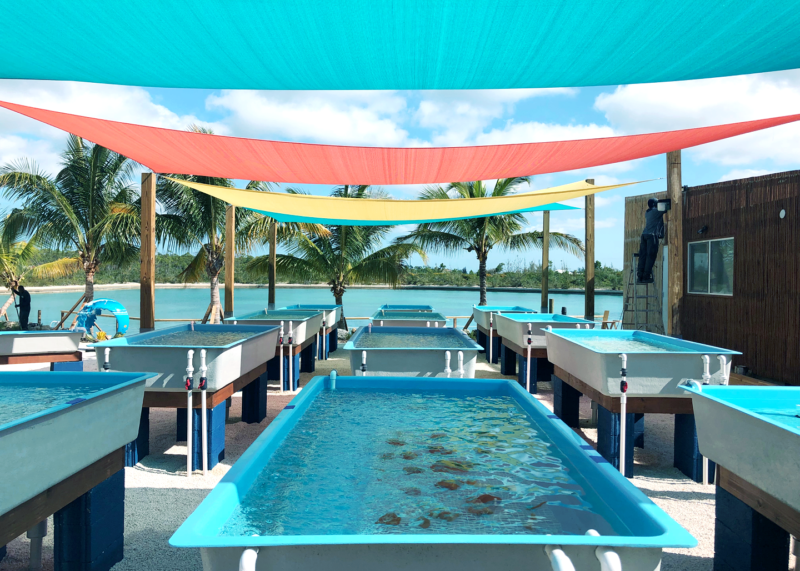Coral reefs are the lifeline to millions of species. They support local economies, and they protect homes, land, and people from the damaging effects of tropical storms. But around the world, coral reefs are dying at a rapid rate; they are endangered, and often wiped out by overfishing, pollution, and the planet’s rising temperatures.
“Half the world’s coral has been lost to human-made causes,” says Sam Teicher, a WeWork member with global access and cofounder of Coral Vita, a coral-restoration company building a network of land-based coral farms to revive the coral population as quickly and safely as possible. “And while the average person probably doesn’t think about coral on a daily basis, its depletion has a devastating impact on the way the world works.”
Teicher’s passion for the ocean and desire to “protect the planet and communities that depend on a healthy ecosystem” led him and his cofounder, Gator Halpern, to found their coral-restoration business in 2015 while in grad school. In 2017, Coral Vita was a runner-up in WeWork’s Creator Awards, receiving $72,000 to fund its mission. In May 2019, the team launched the world’s first commercial, land-based farm for coral restoration in the Grand Bahama, in partnership with the Grand Bahama Port Authority

How land-based coral restoration works
The pilot coral farm in the Grand Bahama is made up of raceway tanks that are pumped with fresh ocean water. There, coral fragments are grown using a process called microfragmentation, in which existing coral pieces are taken from the ocean, cut into small pieces, and placed near each other in seawater, where the pieces will start fusing back together—fast. Microfragmentation, which was pioneered by Coral Vita’s advisor, Dr. David Vaughan, takes advantage of corals natural healing process.

Coral normally takes about 25 to 50 years to grow naturally in the ocean—a time span for which Teicher says we can’t afford to wait. But the coral grown in Coral Vita’s land-based farms grow decades—yes, decades—faster than coral does in its natural habitat. Teicher says that their farmed coral can mature as quickly as six to 24 months, at which point it’s ready to return to the ocean, where it can breathe new life into suffering reefs.


Once the coral has properly developed on land, Coral Vita divers take the multiplied pieces back to the ocean, sometimes using an environmentally safe glue to position the coral into the rocks where it had previously been living. The coral can also self-attach, and once it’s back in the sea, it will continue to grow.
The current Coral Vita facility can grow around 10,000 coral fragments annually. “Ultimately we want this farm to grow hundreds of thousands if not millions of coral fragments per year. We plan to eventually scale this globally and create large-scale land-based coral farms in every country and territory with reefs around the world,” says the cofounder.

In the lab, Coral Vita’s team is exploring assisted evolution, a process they’ve been able to implement through the guidance of Dr. Ruth Gates. Assisted evolution is “basically like taking the coral to the gym and training them” in order to better handle rising temperatures and other fluctuating environmental factors, says Teicher. There’s still a lot of research to be done in this area.




Coral restoration is not the sole solution
Teicher is hopeful about the future of reefs, especially because their sustainability impacts so much of the world—it touches people who may not give a second thought to environmental issues. There are plenty of entry points to care: “Up to a billion people in the world depend on coral reefs,” says Teicher, adding that local economies thrive off tourism and other forms of recreation tied to reefs. He says reefs generate some $30 billion every year.
In addition to losing species like turtles, clown fish, and rays, the depletion of reefs directly impacts families who rely on certain fish populations to feed their families. If you like eating seafood, Teicher says it’s time to care about reefs. If a strong workforce is important to you, prioritize the health of coral: Jobs will disappear and scuba and snorkeling industries have little to profit from. If you dream of relaxing on a white sandy beach on your next vacation, consider how sand, which forms out of the remains of coral reefs, could diminish as reefs continue to.
But Teicher is also acutely aware that restoration alone won’t bring on the environmental change the planet desperately needs. “The best thing to do for coral reefs isn’t to restore them, but to stop killing them,” he says. “So we need our leaders to solve climate change immediately; we need to stop the destruction of our reefs as we work to scale up restoration to help keep them alive. We all depend on them more than we know.”







